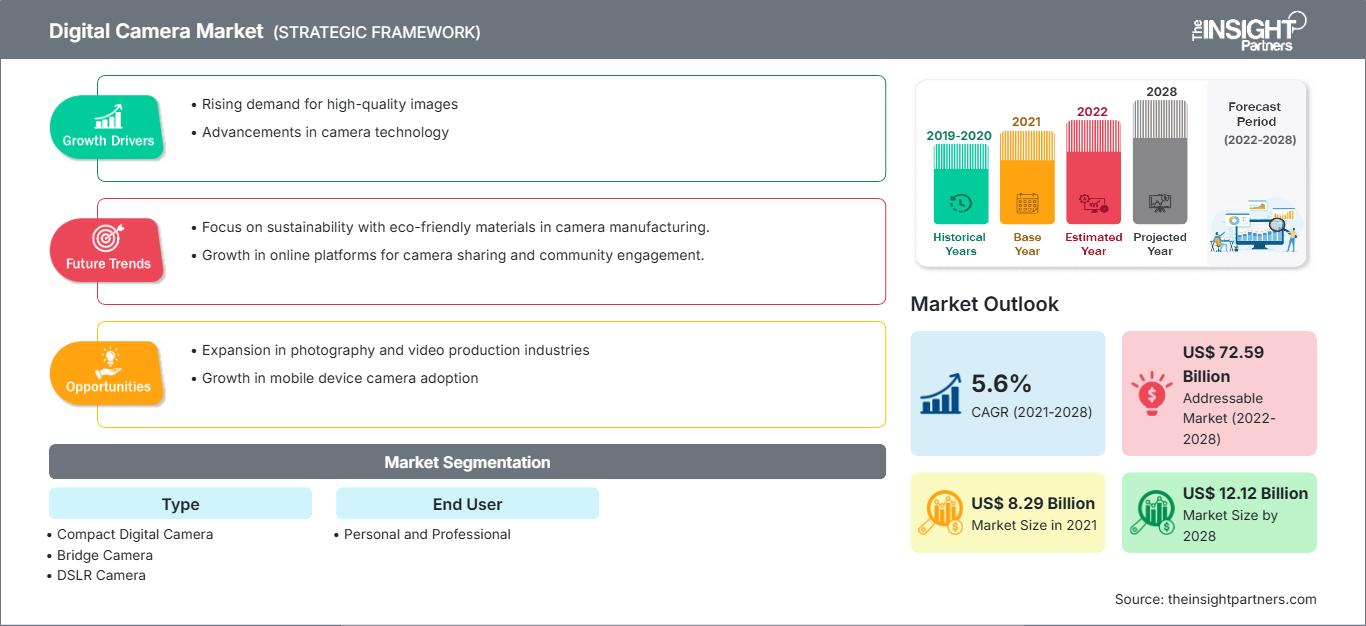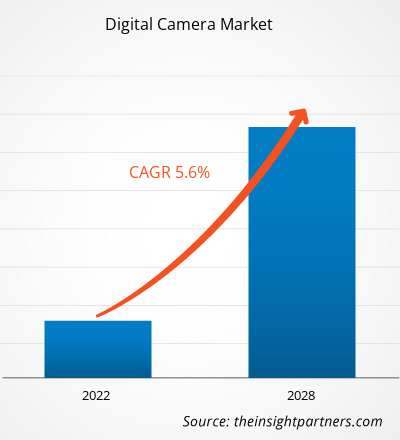Se espera que el mercado de cámaras digitales crezca de US$ 8.290,25 millones en 2021 a US$ 12.119,44 millones en 2028; se estima que crecerá a una CAGR del 5,6% durante 2021-2028.
El uso de cámaras digitales no se limita a la fotografía personal y profesional, sino que se ha extendido a las industrias del entretenimiento, los medios de comunicación y el deporte. La industria cinematográfica es una de las más grandes y lucrativas del sector global del entretenimiento. Por ejemplo, la industria cinematográfica china es una de las más grandes del mundo, con ingresos de aproximadamente 6.600 millones de dólares estadounidenses en 2016. Se espera que este prometedor panorama para la industria del cine y el entretenimiento impulse la demanda de cámaras digitales para lograr tomas y vídeos perfectos. Los rápidos cambios tecnológicos, el comportamiento del consumidor y los modelos de negocio han transformado la forma en que los consumidores desean experimentar y pagar por el entretenimiento y los medios de comunicación. Los líderes de esta industria se centran en crear negocios y marcas centrados en los aficionados para producir contenido excepcional. Como resultado, invierten una cantidad significativa en tecnologías y equipos como imágenes generadas por computadora (CGI) y efectos visuales (VFX), así como en cámaras avanzadas.
Además, el uso de cámaras digitales en los medios deportivos es indispensable. La instalación de cámaras digitales y de alta velocidad en los estadios permite a los espectadores ver repeticiones a cámara lenta en situaciones críticas del partido y ayuda a obtener mayor precisión durante la observación. De igual manera, el uso de cámaras digitales de alta resolución en fotografía de vida silvestre, paisajes, arquitectura y estudio permite obtener imágenes y videos nítidos y definidos. El creciente interés por la fotografía de acción ha impulsado la demanda de cámaras digitales compactas, como GoPro. Además, las plataformas de redes sociales, como Instagram, han ampliado considerablemente el alcance de la fotografía, lo que, a su vez, se espera que impulse el crecimiento del mercado de las cámaras digitales.
Obtendrá personalización en cualquier informe, sin cargo, incluidas partes de este informe o análisis a nivel de país, paquete de datos de Excel, así como también grandes ofertas y descuentos para empresas emergentes y universidades.
Mercado de cámaras digitales: perspectivas estratégicas

-
Obtenga las principales tendencias clave del mercado de este informe.Esta muestra GRATUITA incluirá análisis de datos, desde tendencias del mercado hasta estimaciones y pronósticos.
Impacto de la pandemia de COVID-19 en el mercado europeo de cámaras digitales:
La pandemia del coronavirus ha afectado a las economías e industrias de varios países debido a confinamientos, prohibiciones de viaje y cierres de empresas. La industria de la electrónica de consumo es una de las principales que sufre graves interrupciones, como interrupciones en la cadena de suministro y cierres de plantas de producción, entre otras, debido a esta pandemia. El cierre de diversas plantas de fabricación y fábricas en regiones clave como Norteamérica, Europa, Asia Pacífico, Sudamérica, Oriente Medio y África ha afectado a la cadena de suministro global y ha afectado negativamente a la fabricación, los plazos de entrega y las ventas de diversos productos. Además, varias empresas ya han anunciado posibles retrasos en las entregas de productos y una caída en las ventas futuras. Asimismo, las prohibiciones de viaje impuestas por países de Europa, Asia y Norteamérica están afectando las oportunidades de colaboración y asociación empresarial. Se prevé que todos estos factores afecten negativamente a la industria de la electrónica de consumo y, por lo tanto, frenen el crecimiento de diversos mercados relacionados con esta industria en los próximos meses. El mercado de las cámaras digitales se ve afectado por la pandemia debido a la escasez de producción y a las limitadas instalaciones de transporte.
Perspectivas del mercado de cámaras digitales
Las innovaciones tecnológicas asociadas con las cámaras digitales impulsarán el crecimiento del mercado de cámaras digitales
El mercado de las cámaras digitales está estrechamente vinculado a tendencias radicales emergentes, impulsadas por innovadores desarrollos tecnológicos y avances robustos, como la alta definición y las pantallas táctiles. Desde hace tiempo, el mercado ha observado una mayor demanda de cámaras réflex digitales de un solo objetivo y cámaras réflex digitales (SLR) debido a la creciente inclinación de los consumidores hacia la fotografía avanzada. Sin embargo, el avance tecnológico ha dado lugar a la creación de cámaras de alta resolución, con una resolución de entre 12 y 20 megapíxeles. La continua evolución en el campo de las cámaras digitales ha dado lugar al diseño de cámaras avanzadas con mejor resolución, enfoque más rápido y compatibilidad con diferentes periféricos. Asimismo, se ha observado una creciente tendencia a incorporar un módem Wi-Fi o 4G en las cámaras digitales, lo que proporciona una ventaja competitiva frente a los smartphones. Además, se prevé que estas cámaras formen parte de diversos dispositivos interconectados, como el IoT (Internet de las Cosas), lo que podría facilitar la comunicación eficaz con otros dispositivos interconectados, como smartphones y asistentes de voz, en un futuro próximo.
Perspectivas del mercado basadas en tipos
Según el tipo, el mercado de cámaras digitales se clasifica en: compactas, bridge, réflex digitales (DSLR), sin espejo, con telémetro digital y con escaneo lineal. En 2020, el segmento de cámaras réflex digitales (DSLR) representó la mayor cuota de mercado.
Perspectivas regionales del mercado de cámaras digitales
Los analistas de The Insight Partners han explicado detalladamente las tendencias y los factores regionales que influyen en el mercado de cámaras digitales durante el período de pronóstico. Esta sección también analiza los segmentos y la geografía del mercado de cámaras digitales en Norteamérica, Europa, Asia Pacífico, Oriente Medio y África, y Sudamérica y Centroamérica.
Alcance del informe del mercado de cámaras digitales
| Atributo del informe | Detalles |
|---|---|
| Tamaño del mercado en 2021 | US$ 8.29 mil millones |
| Tamaño del mercado en 2028 | US$ 12.12 mil millones |
| CAGR global (2021-2028) | 5,6% |
| Datos históricos | 2019-2020 |
| Período de pronóstico | 2022-2028 |
| Segmentos cubiertos |
Por tipo
|
| Regiones y países cubiertos |
América del norte
|
| Líderes del mercado y perfiles de empresas clave |
|
Densidad de actores del mercado de cámaras digitales: comprensión de su impacto en la dinámica empresarial
El mercado de las cámaras digitales está creciendo rápidamente, impulsado por la creciente demanda de los usuarios finales debido a factores como la evolución de las preferencias de los consumidores, los avances tecnológicos y un mayor conocimiento de las ventajas del producto. A medida que aumenta la demanda, las empresas amplían su oferta, innovan para satisfacer las necesidades de los consumidores y aprovechan las tendencias emergentes, lo que impulsa aún más el crecimiento del mercado.

- Obtenga una descripción general de los principales actores clave del mercado de cámaras digitales
Información del mercado basada en el usuario final
Según la aplicación, el mercado de cámaras digitales se segmenta en personal y profesional. En 2020, el segmento profesional representó una mayor cuota de mercado.
Los actores del mercado digital adoptan estrategias como fusiones, adquisiciones e iniciativas de mercado para mantener su posición en el mercado. A continuación, se enumeran algunos avances de los actores clave:
- FUJIFILM Holdings Corporation anunció el lanzamiento de la FUJIFILM GFX100S a fines de febrero de 2021. La cámara es la última incorporación a la serie GFX de cámaras digitales sin espejo.
- Nikon Corporation lanzó la cámara sin espejo de fotograma completo Z 7II. Esta cámara es de fotograma completo y alta resolución. Con estos lanzamientos, la compañía contribuye al desarrollo de la cultura de la imagen.
El mercado de cámaras digitales se ha segmentado de la siguiente manera:
Por tipo
- Cámara digital compacta
- Cámara puente
- Cámara DSLR
- Cámara sin espejo
- Cámara con telémetro digital
- Cámara de escaneo lineal
Por el usuario final
- Personal
- Profesional
Por geografía
-
América del norte
- A NOSOTROS
- Canadá
- México
-
Europa
- Francia
- Alemania
- Italia
- Reino Unido
- Rusia
- Resto de Europa
-
Asia Pacífico (APAC)
- Porcelana
- India
- Corea del Sur
- Japón
- Australia
- Resto de APAC
-
Oriente Medio y África (MEA)
- Sudáfrica
- Arabia Saudita
- Emiratos Árabes Unidos
- Resto de MEA
-
América del Sur (SAM)
- Brasil
- Argentina
- Resto de SAM
Perfiles de empresas
- Canon Inc.
- Compañía Eastman Kodak
- Corporación Fujifilm Holdings
- Cámara Leica Ag
- Corporación Nikon
- Corporación de Soluciones Digitales Om
- Corporación Panasonic
- Hasselblad
- Compañía de imágenes Ricoh, Ltd.
- Corporación Sony
- Análisis histórico (2 años), año base, pronóstico (7 años) con CAGR
- Análisis PEST y FODA
- Tamaño del mercado, valor/volumen: global, regional y nacional
- Industria y panorama competitivo
- Conjunto de datos de Excel
Informes recientes
Informes relacionados
Testimonios
Razón para comprar
- Toma de decisiones informada
- Comprensión de la dinámica del mercado
- Análisis competitivo
- Información sobre clientes
- Pronósticos del mercado
- Mitigación de riesgos
- Planificación estratégica
- Justificación de la inversión
- Identificación de mercados emergentes
- Mejora de las estrategias de marketing
- Impulso de la eficiencia operativa
- Alineación con las tendencias regulatorias






















 Obtenga una muestra gratuita para - Mercado de cámaras digitales
Obtenga una muestra gratuita para - Mercado de cámaras digitales